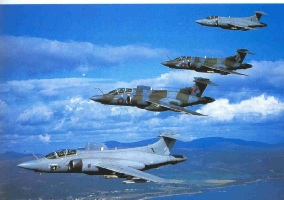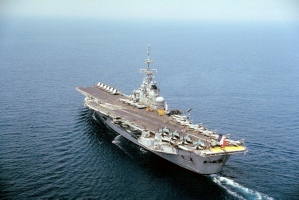BUCCANEERS OVER BEIRUT
In September 1983, elements of the British Army stationed in Beirut were perceived to be at risk. Operation PULSATOR was mounted to cover the detachment of six Buccaneers, from Lossiemouth’s Nos 12 and 208 Sqns, to Akrotiri whence they were to provide air support for British Forces deployed in the Lebanon (BRITFORLEB).
stationed in Beirut were perceived to be at risk. Operation PULSATOR was mounted to cover the detachment of six Buccaneers, from Lossiemouth’s Nos 12 and 208 Sqns, to Akrotiri whence they were to provide air support for British Forces deployed in the Lebanon (BRITFORLEB).
Operating alongside their American, French and Italian counterparts, the 102 officers and men of the UK contingent of the multi-national peacekeeping force in Beirut, had been occupying a block of flats in the Hadath area of the city since the previous February. Their primary role was to prevent the many local factions (which included Druze militia, Shi’ites, Sunnis and the Lebanese Army) from destroying the city as they fought each other.
Unfortunately, by September the situation was getting worse, not better, and it seemed that the peacekeepers were likely to become targets themselves. The morale of the American element (Marines deployed ashore) was maintained by the close proximity of the US 6th Fleet, also known as Carrier Task Force 60 (CTF60), which could field well over 100 fixed-wing combat aircraft. Similarly, the French forces ashore were reassured by the presence of the aircraft carrier Foch and its air wing of Etendards. These shipborne aircraft could, in theory at least, retaliate in response to any direct or indirect threat to the ground forces. This was not the case for the 102 British officers and men of BRITFORLEB and their morale was deemed to be suffering because they felt extremely vulnerable and isolated in their part of the city where they lacked any means of support, ground or air. Hence MOD’s decision to deploy attack aircraft to Cyprus.
by September the situation was getting worse, not better, and it seemed that the peacekeepers were likely to become targets themselves. The morale of the American element (Marines deployed ashore) was maintained by the close proximity of the US 6th Fleet, also known as Carrier Task Force 60 (CTF60), which could field well over 100 fixed-wing combat aircraft. Similarly, the French forces ashore were reassured by the presence of the aircraft carrier Foch and its air wing of Etendards. These shipborne aircraft could, in theory at least, retaliate in response to any direct or indirect threat to the ground forces. This was not the case for the 102 British officers and men of BRITFORLEB and their morale was deemed to be suffering because they felt extremely vulnerable and isolated in their part of the city where they lacked any means of support, ground or air. Hence MOD’s decision to deploy attack aircraft to Cyprus.
The types considered were the Tornado, the Jaguar and the Buccaneer. The prime requirement was the ability to deliver an extremely accurate attack, the aim being to achieve maximum effect whilst minimising the risk of collateral damage or injury to friendly forces. The threat to BRITFORLEB was assessed to be from either long-range artillery or an assault from within the city itself. While the Tornado’s on board nav/attack system could certainly provide much of the required degree of accuracy, it was ruled out because of its poor radius of action, its inability (at the time) to deliver Laser Guided Bombs (LGB) and a still untried deployment capability. The Jaguar had an accurate navigation system and it could deliver a precision attack using LGBs, but it lacked the ability to laser designate









 stationed in Beirut were perceived to be at risk. Operation PULSATOR was mounted to cover the detachment of six Buccaneers, from Lossiemouth’s Nos 12 and 208 Sqns, to Akrotiri whence they were to provide air support for British Forces deployed in the Lebanon (BRITFORLEB).
stationed in Beirut were perceived to be at risk. Operation PULSATOR was mounted to cover the detachment of six Buccaneers, from Lossiemouth’s Nos 12 and 208 Sqns, to Akrotiri whence they were to provide air support for British Forces deployed in the Lebanon (BRITFORLEB).  by September the situation was getting worse, not better, and it seemed that the peacekeepers were likely to become targets themselves. The morale of the American element (Marines deployed ashore) was maintained by the close proximity of the US 6th Fleet, also known as Carrier Task Force 60 (CTF60), which could field well over 100 fixed-
by September the situation was getting worse, not better, and it seemed that the peacekeepers were likely to become targets themselves. The morale of the American element (Marines deployed ashore) was maintained by the close proximity of the US 6th Fleet, also known as Carrier Task Force 60 (CTF60), which could field well over 100 fixed-







